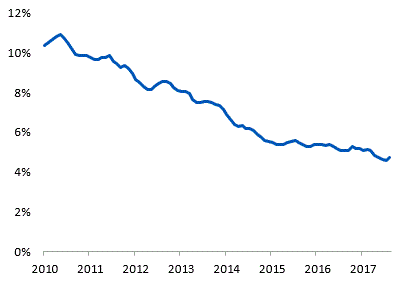Since the great recession, the industrial segment of the US temporary staffing market has nearly doubled in size to reach an estimated $33 billion this year, according to our most recent forecast. After a strong run of expansion, the market declined in 2016 and the projected growth rate for 2017 and 2018 is a modest 2%, with arguably the biggest headwind being a shortage of available candidates to fill orders. In this article, we take a closer look at the factors shaping the candidate shortage, and ways that industrial staffing firms can best respond to the current “candidate-driven” market.
Factors driving candidate scarcity
With August marking the 83rd consecutive month of job growth in the economy, the most obvious explanation for growing candidate scarcity is simply that available workers have been hired into a growing US economy, as part of the expansion phase of the business cycle.
One way to gauge the cyclical impact is to look at the unemployment rate for high school graduates with no college (a proxy for industrial staffing candidates), which averaged 4.7% during June, July and August. The metric has steadily declined from a peak of 11.0% in 2010 down to its current level, as shown in the accompanying graph, painting a picture of the dwindling excess supply of labor.
Unemployment rate for high school graduates with no college (3 mo avg)
In previous cycle lows, the rate averaged 3.5% in 2000 and 4.3% in 2006, suggesting that the labor market could tighten even further this cycle. While the current unemployment rate may not be at a historic low, the shortage of candidates is being exacerbated by the following current factors:
- Heightened restrictions and enforcement regarding immigration. While a reduction in undocumented workers does not have a direct effect on industrial staffing firms that verify employment authorization, there is an indirect effect of more employers competing for a shrinking supply of legally authorized workers.
- More common drug use. Recently announced as a national emergency, the abuse of opioid painkiller medications without a prescription was estimated to involve 12 million Americas, according to a 2015 government survey, further eroding the supply of eligible candidates.
- A rise in gig work. While Uber and Lyft now engage several hundred thousand active drivers, there are also growing opportunities for individuals to earn money via hospitality and event-related gigs, further siphoning off the supply of potential candidates for industrial staffing.
Taken together, these factors help explain why some industrial staffing executives have described the current environment as a setting of significant candidate scarcity, and even among the most challenging that they have experienced.
Staffing firm strategies
Given the current environment, how can industrial staffing firms best position themselves to grow and prosper? Based on conversations with industrial staffing leaders, some common strategic approaches emerge:
- Add value to your clients by helping them maximize their attractiveness to candidates. Serve as a business partner by offering market intelligence that helps clients set competitive pay rates and benefits. Alternatively, advise clients on how they may need to adjust or simplify their minimum qualifications in order to effectively acquire the workers that they need.
- Enlarge the talent pool by accessing less typical sources of workers. With more typical sources of candidates in scarce supply, some industrial staffing firms are reaching out to retirees, workers with disabilities, part-time workers, workers not in the labor force (such as a stay-at-home parent), and even apprenticeship programs with students, to give a few examples.
- Add value to both workers and clients by working to connect scarce talent with the best possible job match. As the name “candidate-driven market” implies, workers with multiple job options will tend to migrate toward the employer that best matches their preferences. To the extent staffing firms can facilitate this process, they can increase the satisfaction of all involved.
The industrial staffing segment appears to have entered into a period of candidate scarcity that has not been seen in many years. This environment represents both a headwind to growth, but also opportunities for success for those organizations nimble enough to adapt their strategy and tactics.








